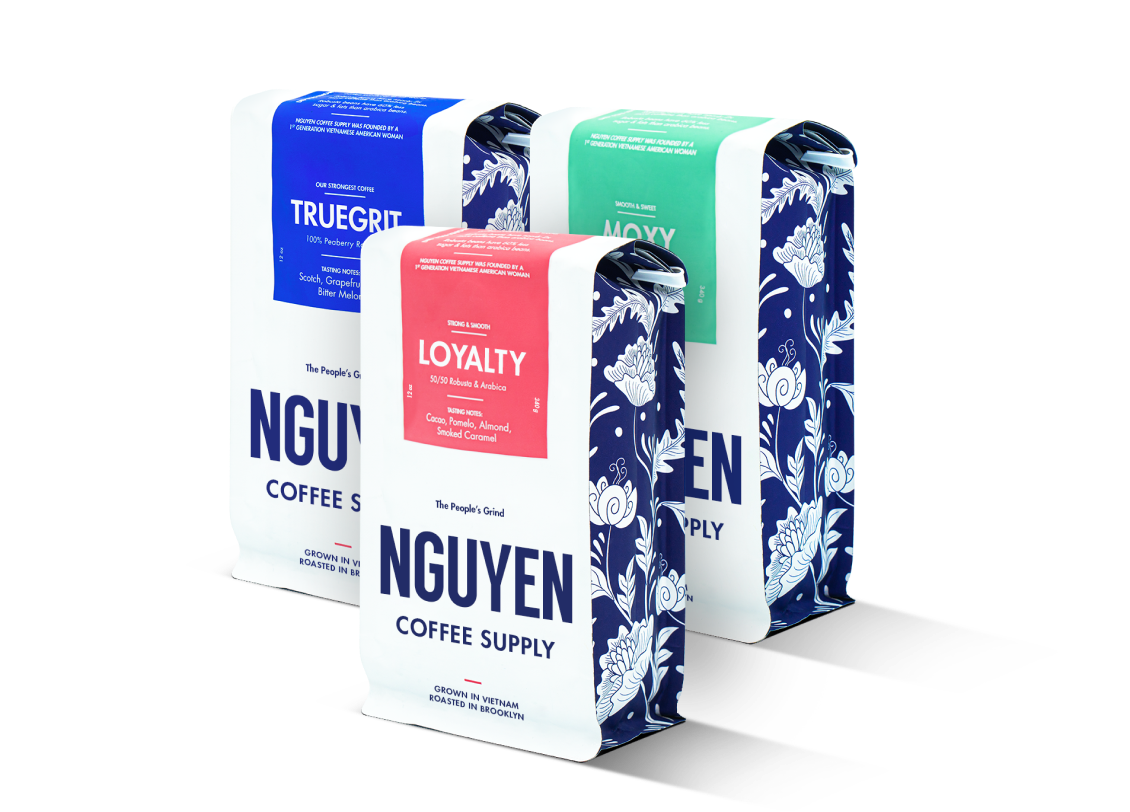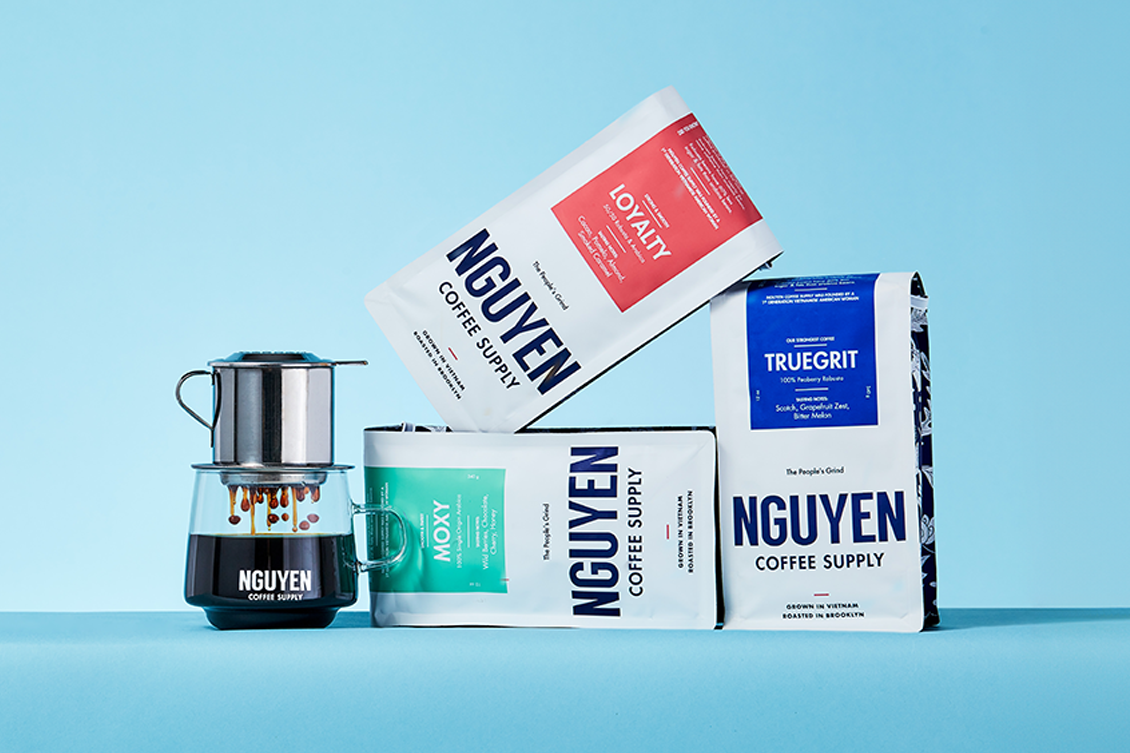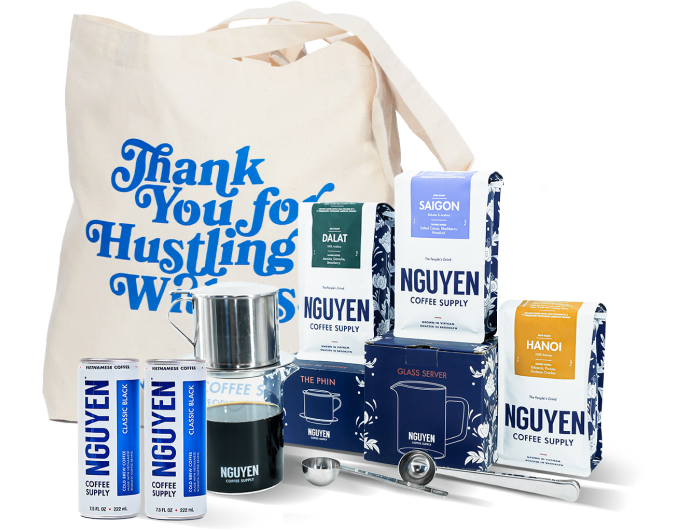

- FAN FAVORITE

Create for yourself or as a gift for your loved ones
Subscribe nowMe and mom just enjoyed the Nguyen phin drip experience. Wow. Proud of your work. We without hesitation enjoy the Vietnamese coffee and recommend your products. Thank-you to the Nguyen staff and tradition. From Canada eh!
Summer is here, which means that it is officially iced coffee season (although some people would say that’s all year). What better beverage to enjoy during these hot days than a refreshing, tall glass of sweet and bold Vietnamese iced coffee?
Vietnamese iced coffee (or cà phê sữa đá) is a beverage native to Vietnam that has gained immense popularity and a huge fan base over the last few years. To fully understand why Vietnamese iced coffee has captivated the hearts of so many coffee lovers, we need to take a look at Vietnamese coffee itself.
A common misconception is that Vietnamese coffee is simply coffee with condensed milk—this is not true. The misunderstanding stems from the fact that a lot of Vietnam-born coffee drinks are traditionally sweetened using condensed milk, but that’s just a common ingredient there. Vietnamese people also enjoy their coffee black. More on condensed milk later.
Vietnam has one of the best coffee cultures in the world. Vietnam is the world’s biggest coffee grower and exporter of robusta coffee. There is a rich culture of thoughtful farming and Vietnamese people are very proud of their coffee. In addition, coffee culture in Vietnam is incredibly diverse, ranging from street carts to specialty cafes, and always centered around socializing and community gathering. Vietnam is home to many different types of coffee beverages from Vietnamese iced coffee to others such as the famous egg coffee, coconut coffee, and more!
The best way to uplift and understand Vietnamese coffee is to define it as coffee made from beans grown in Vietnam – this framework centers Vietnamese people, farmers, and communities in the transaction of consuming Vietnamese coffee. It is wrong to use non-Vietnamese coffee beans in a drink and call it “Vietnamese Iced Coffee” just because one adds sweetened condensed milk. This approach lacks cultural integrity, renders the actual farmer invisible, and excludes Vietnamese farmers from this transaction.
Furthermore, any sort of drink can be called Vietnamese as long as you make it with Vietnamese coffee beans. You can drink Vietnamese espresso, latte macchiato, or even a Vietnamese chai latte! Therefore, how one would engage with Colombian coffee can be as similar as how one might approach Vietnamese coffee. It’s all about the beans!
One important thing about Vietnamese coffee, and about Vietnamese iced coffee in particular, is the phin filter. The phin (often called the phin coffee maker or phin drip filter) is a brewing method native to Vietnam. It’s a drip coffee maker that we often describe as a hybrid between a French press and a pour over such as the V60 that has been around for more than a century.
In Vietnam, coffee culture is centered around the phin filter and its slow drip method. As the coffee slowly drips from the phin filter into the glass, coffee becomes a time for gathering, slowing down and self-care.
When it comes to iced coffee, the phin filter almost seems to have been created with that specific use in mind. Because it makes a very concentrated brew, it is perfect for making iced coffee because even as the ice melts down, we can still enjoy a bold coffee that does not feel watered down.
Not only that, but the phin filter is one of the greatest alternatives to other methods like the French press. First of all, it’s quite versatile. You can easily make most popular types of coffee beverages with a phin filter. Because it makes a very concentrated coffee, it effectively replaces espresso in a myriad of espresso-based drinks!
Secondly, the phin filter is one of the best value coffee makers you’ll ever find. It’s not just that it’s incredibly inexpensive compared to most other brewing methods, but it’s also quite durable.
Lastly and also importantly, phin filters are one of the most sustainable brewing methods out there. There is no paper filter required, making the phin filter an eco-friendly brew tool. They are made 100% of stainless steel—which is already recycled and it’s at the same time fully recyclable. In an industry that is awash with wasteful practices, the phin filter stands out as a completely green product that takes care of the environment instead of adding to its pollution.
Check out our phin filter guide so that you can get familiar with how it works and what is the best way of brewing coffee using one!
As we said earlier: it’s all about the beans. Vietnamese beans are consumed all over the world every day and are some of the most coveted beans among coffee drinkers. For such a popular coffee, there is one special thing: Vietnamese coffee is almost always robusta.
About 90% of all coffee produced in Vietnam is robusta. Arabica wasn’t traditionally grown in the country until the early 2000s when high demand of arabica inspired some Vietnamese farmers to start growing arabica. But traditionally, Vietnamese coffee has always been robusta.
What does that mean? Well, robusta and arabica are two kinds of plants, both of the Coffeea family. That means that they are both coffee trees, but with different characteristics. This is also true of the fruit they produce and by extension of the seeds within those fruits, which is what we roast, ground, and brew to make our daily coffee.
Robusta beans have historically been relegated to a secondary role because of how easy to farm it is. Arabica, however, needs much more stable temperatures and higher altitudes to grow—and we all know that scarcity means that a product is going to be seen as more desirable. The less there is of something, the more people want it.
So arabica became a much pricier, exotic type of coffee that only elites could really enjoy. Robusta was farmed in massive quantities and enjoyed by the middle and working classes, while the aristocracy of Europe enjoyed arabica.
With time, however, this has changed. The 20th century saw the combination of arabica and robusta beans as a blend. Even today, many coffee blends have a little robusta to help balance out the taste and up the amount of caffeine in it (think Italian espresso).
After the Third Wave of coffee, the role of robusta has begun to be questioned. It is no longer just a mass-produced coffee that is only consumed because it is easier to grow and cheaper to buy; instead, people have begun to appreciate robusta for its unique taste that isn’t inferior to that of arabica, just different. Robusta has a lot of nutty and chocolate-like flavor notes that would otherwise be highly coveted in arabica coffee but are overlooked simply because it isn’t robusta.
A revolution in the coffee industry is happening regarding robusta, and we’re proud to be pioneering the Vietnamese coffee movement. Robusta is beginning to be seen as just as desirable—or sometimes more—than arabica beans. Vietnam has been a great driver for this, as Vietnam is the second largest producer of coffee in the world. Thanks to this, people all over the world are starting to see robusta in a new light with more varieties of robusta being produced these days.
Let’s take a look at some of the characteristics of robusta and arabica beans to get a clearer picture of how they are different from each other:
In the end, robusta beans are an intrinsic part of Vietnamese coffee and of Vietnamese coffee culture. All coffee preparations, beverages, etc. are centered around the coffee that is grown and consumed in the country: robusta.
Essentially, a Vietnamese iced coffee made without using robusta can hardly be called such. You can brew the coffee using a French press; you can use creamer or oat milk instead of condensed milk. But if you don’t use robusta coffee beans, the taste is just not nearly the same.
Condensed milk and Vietnam go way back. It was first introduced by the French in the 1860s. France actually saw the invention of condensed milk.
Milk has long been a good source of nutrition for many people, and a pretty tasty one at that. The beauty of condensed milk is that, while regular milk only lasts a few days and up to a month or two before spoiling, condensed milk can actually go years without going bad.
First, a French scientist came up with the idea of boiling milk and then preserving it in a heated container. This made for a thicker drink that had been sanitized thanks to the heat.
A few years later, canning was invented. This method used sugar as a food preservative and, at the same time, protected food from any contact with the outside world. Thus, condensed milk was born.
But it wasn’t simply a coincidence that condensed milk became so popular in Vietnam. Robusta has a distinctly bold and nutty flavor that complements the smooth sweetness of condensed milk. It creates a perfect balance between the boldness of the coffee and the sweetness of the condensed milk. One is very sweet, the other very intense. Together, they make an irresistible drink.
And that’s not all. Condensed milk acts also as a sweetener, meaning that it is one of the most ideal ingredients for coffee that can come to mind. It is both dairy and sweetener all in one. This is why Vietnamese iced coffee is so popular and unique: the existence of such a convenient ingredient such as condensed milk makes it possible.
Texture also plays a big role. Condensed milk has a unique texture that is achieved by boiling the milk along with the sugar. It is creamy, soft, and thick at the same time and it can make almost any beverage or dessert better. Thus, Vietnamese coffee achieves great flavor, sweetness, and great texture with just one ingredient.
Condensed milk is so good that there are Vietnamese coffee beverages that are born more of a love of condensed milk than of actual coffee. There’s Bạc Xỉu, for example, which is more of a tall glass of condensed milk with a few ounces of coffee. It’s just like a latte macchiato, but using delicious condensed milk.
As you can see, each of the three components of traditional Vietnamese iced coffee have their own history and place within Vietnamese coffee culture. Every one of them is complex and has its own history, and together they have a shared history that is intertwined with the history of the country.
A true Vietnamese iced coffee will always have the three things that make it Vietnamese: coffee made using a phin filter, robusta beans, and condensed milk to sweeten it. Using other brewing methods, other types of coffee, or even any other sort of creamer or sweetener is totally acceptable… but it doesn’t make true Vietnamese iced coffee, rather a “Vietnamese-inspired” iced coffee at best.
Therefore, to make a traditional Vietnamese iced coffee, you need all three. The Phin filter can be found here, and authentic Vietnamese robusta coffee can be found here. As for condensed milk, there’s plenty of it in your nearest supermarket, as it’s a pretty popular product. There’s little difference from brand to brand, so help yourself to whichever one appeals to you.
Our final note and reminder: this is a coffee drink and should not be conflated with Vietnamese coffee overall, which means coffee that is grown and produced in Vietnam. Ultimately, you don’t need all three to enjoy Vietnamese coffee at all– you can have it black or in a variety of other brew methods of your choosing!
––